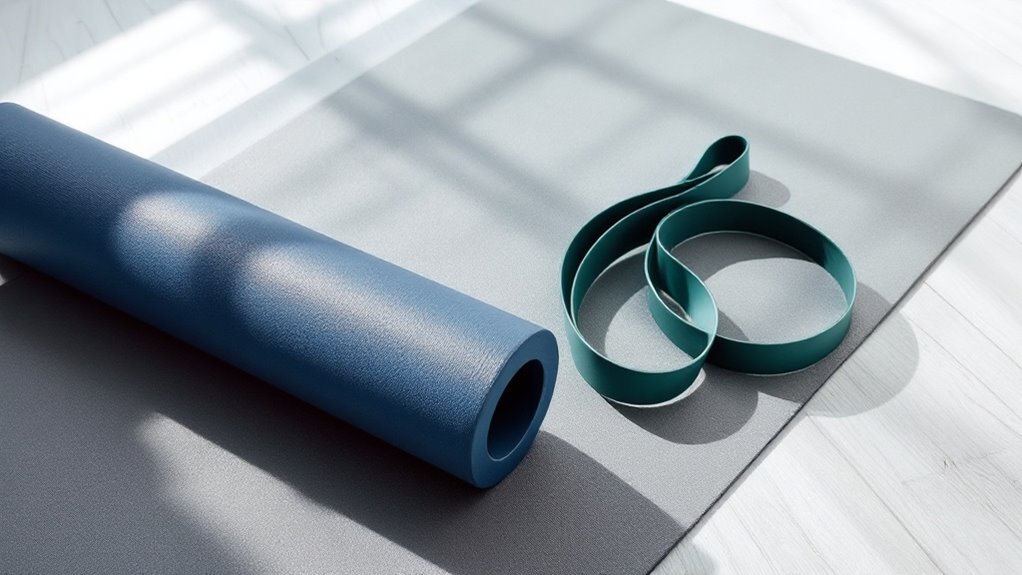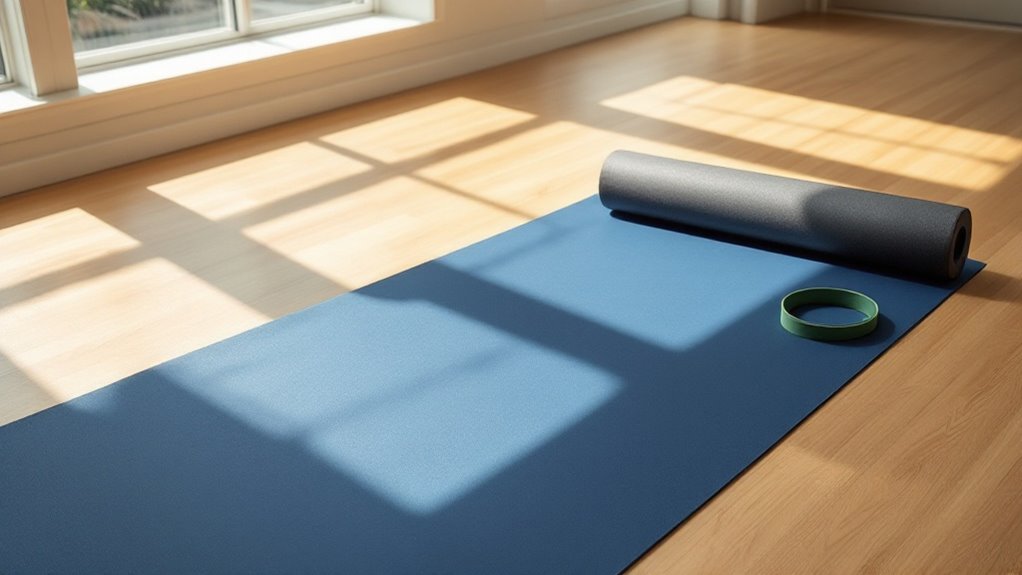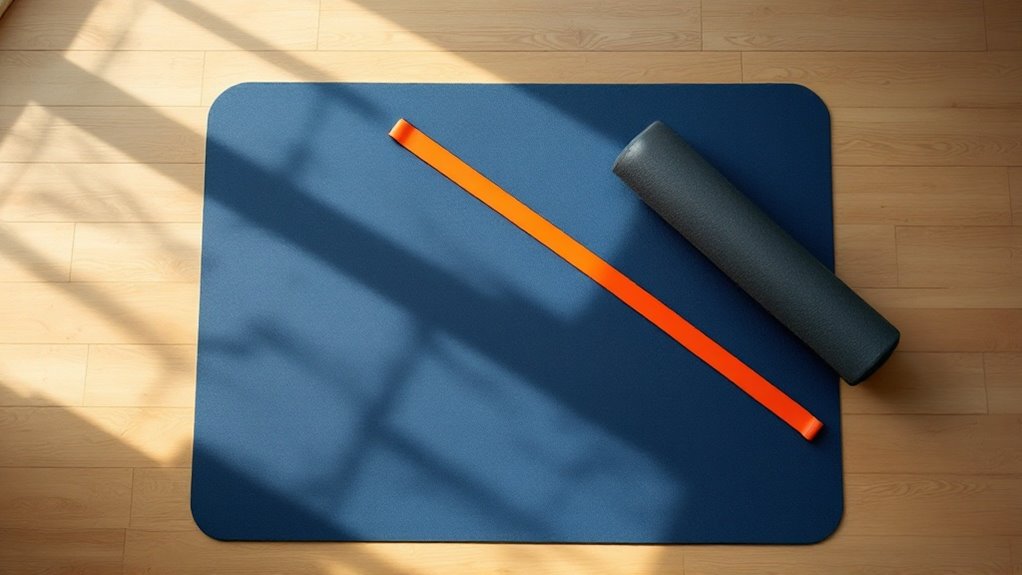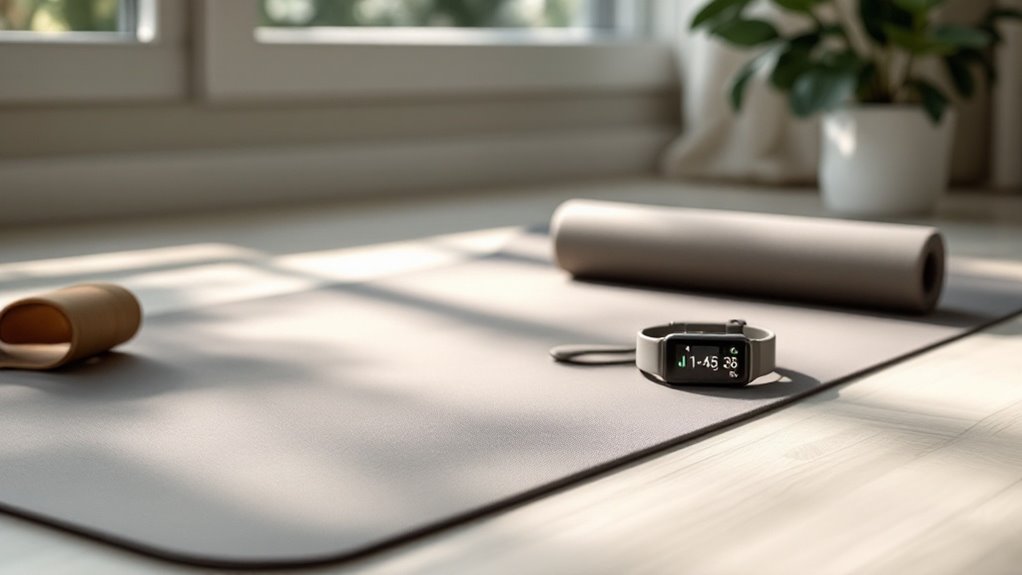How to Stretch Quads

Stretching the quadriceps effectively requires proper form and consistent practice. Begin with basic techniques like the standing quad stretch, holding one foot behind the back while maintaining balance. The lunging quad stretch targets deeper muscle fibers by lowering the back knee toward the ground. For best results, warm up for 5-10 minutes, then hold each stretch for 15-30 seconds while breathing deeply. More advanced techniques await those ready to enhance their flexibility gains.
Key Takeaways
- Perform a standing quad stretch by balancing on one leg and holding your other foot behind your back.
- Execute a lunging quad stretch by kneeling with one knee down and leaning back while keeping your torso upright.
- Warm up for 5-10 minutes before stretching to prevent injury and increase flexibility gains.
- Hold each quad stretch for 15-30 seconds while breathing deeply and avoiding bouncing movements.
- Practice prone quad stretches by lying face-down, bending one knee, and grasping your foot with the same-side hand.
Understanding Quad Muscles and Why Stretching Matters

The quadriceps, a powerhouse group of four muscles located at the front of the thigh, plays an essential role in everyday movement and athletic performance. These muscles – the rectus femoris, vastus lateralis, vastus medialis, and vastus intermedius – work together to extend the knee and flex the hip.
Regular quad stretching prevents muscle tightness, reduces injury risk, and improves overall mobility. For athletes and fitness enthusiasts, flexible quads enhance running form, jumping ability, and squatting mechanics.
Tight quadriceps can lead to knee pain, poor posture, and decreased athletic performance. Like a well-oiled machine, properly stretched quads guarantee smooth, efficient movement patterns in both daily activities and intense workouts.
Essential Quad Stretching Techniques for Beginners

Starting a quad stretching routine requires mastering fundamental techniques that build a strong foundation for more advanced moves.
Three essential stretches form the core of quad training for beginners. The standing quad stretch involves holding one foot behind your back while maintaining balance.
Begin with three fundamental quad stretches, mastering the standing position by balancing while holding your foot behind you.
The lunging quad stretch requires stepping forward into a lunge position, lowering the back knee toward the ground.
The prone quad stretch is performed lying face-down, bending one knee and grasping the foot.
Each stretch should be held for 15-30 seconds, breathing deeply and maintaining proper form. Proper execution prevents injury and enhances flexibility gains.
Similar to external shoulder rotation exercises, these stretches help improve posture and reduce the risk of muscle imbalances.
Advanced Quad Stretches for Athletes and Fitness Enthusiasts

Several advanced quad stretches enable athletes and fitness enthusiasts to take their flexibility training to the next level. These dynamic movements require proper form and preparation to optimize benefits while preventing injury. Incorporating these stretches as part of a progressive overload program helps maximize both strength gains and flexibility improvements.
| Exercise | Benefits | Execution Tips |
|---|---|---|
| Dynamic Lunge | Improved mobility | Maintain upright posture |
| Wall Split | Deep stretch | Progress gradually |
| Couch Stretch | Hip flexor release | Keep core involved |
| Banded Pull | Targeted tension | Control resistance |
| Partner-Assisted | Maximum range | Communicate limits |
Athletes should hold these stretches for 30-45 seconds, focusing on controlled breathing and proper positioning. Regular practice of these advanced techniques can markedly improve performance and reduce injury risk during high-intensity activities.
Tips for Safe and Effective Quad Stretching Routines

Proper safety measures and effective techniques lay the foundation for successful quad stretching routines, building upon the advanced movements discussed previously.
To enhance results while preventing injury, stretchers should always warm up for 5-10 minutes before beginning.
Maintaining proper form remains essential. Keep the back straight, core involved, and movements controlled. Never bounce or force stretches beyond comfort. Hold each position for 15-30 seconds, breathing deeply throughout.
Consistency breeds progress. Schedule quad stretching 3-4 times weekly, ideally post-workout when muscles are warm. Track flexibility gains using measurable standards like distance from heel to glute during standing stretches.
Frequently Asked Questions
Can I Stretch My Quads While Sitting at My Desk at Work?
Yes, desk quad stretches are effective and discreet.
While seated, cross one ankle over the opposite thigh near the knee. Gently press down on the raised knee while maintaining good posture. Hold for 15-30 seconds, then switch legs.
Another option: slide forward slightly in the chair, bend one leg under the seat while keeping the other straight.
These stretches help combat prolonged sitting tightness.
Should I Stretch My Quads Before or After Taking Pain Medication?
It's recommended to stretch before taking pain medication to assess the true level of discomfort and flexibility.
This allows for better monitoring of any underlying issues. If pain is severe, consult a medical professional first.
For mild discomfort, gentle stretching followed by medication can be effective.
The medication's pain-masking effects might lead to overstretching if done after taking it.
Why Do My Knees Crack When I Stretch My Quads?
Knee cracking during quad stretches is typically due to gas bubbles releasing in the synovial fluid or tendons moving across joint surfaces.
This common phenomenon, called crepitus, usually isn't cause for concern.
However, if accompanied by pain, swelling, or limited mobility, it could indicate underlying issues like cartilage wear, arthritis, or ligament problems.
Regular stretching and proper form can help minimize excessive cracking.
How Long Should I Wait to Stretch Quads After Eating?
Like a patient gardener waiting for seeds to sprout, timing your post-meal quad stretches requires strategic patience.
Generally, wait 2-3 hours after a large meal before intense stretching. For light meals, 30-60 minutes suffices. This allows proper digestion and blood flow distribution.
During digestion, blood concentrates in the stomach, potentially limiting stretch effectiveness and causing discomfort if performed too soon after eating.
Can Quad Stretching Make You Taller Temporarily?
Quad stretching can create a temporary height increase of a few millimeters due to lengthening of the muscles and improved posture.
This effect typically lasts only minutes to hours as muscles return to their normal state. The height change is minimal and not permanent.
For lasting height benefits, focus on maintaining good posture through regular stretching and strengthening exercises rather than relying on temporary stretching effects.
Final Thoughts
Regular quad stretching transforms both athletic performance and daily mobility. Take Sarah Chen, a former track athlete who suffered recurring knee pain until implementing a structured quad stretching routine. Within eight weeks, her pain decreased by 80%, and her sprint times improved. By incorporating proper quad stretching techniques into their fitness regimens, individuals can prevent injuries, improve performance, and maintain long-term muscle health.


